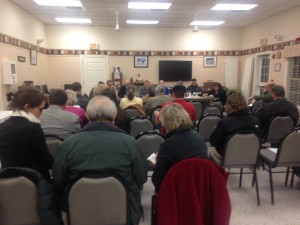The large-scale solar farm project slated for Rochester center continues to inch forward after another session with the Rochester Planning Board on December 8, but an endangered turtle habitat finding from the Natural Heritage & Endangered Species Program has kick started a 60-day process of evaluation of the site, which will lead to a mitigation plan of sorts.
Amelia Tracey of Renewable Energy, LLC said “a take” by Natural Heritage, a term used when it is determined that the site is one of concern, will result in the solar energy company paying a per-acre fee, which will go towards funding research and development on the unspecified turtle species, since other onsite habitat mitigation methods offered were not viable for this particular site.
Tracey said Natural Heritage considered the site located between New Bedford Road and Dexter Lane a low-impact site with an isolated, undisturbed area considered to be turtle habitat. This find will not stop the project from moving forward, although several abutters and townspeople present that night wished it would.
The board granted a partial waiver over the tagging of all trees of a 12-inch caliber or greater at the site, which did not please some people in attendance. Chairman Arnold Johnson maintained that the tagging of trees outside the 20-foot buffer, which were already tagged, would be a pointless measure since all the trees in the interior would be cleared for the solar arrays anyway. And as for stopping the developer from chopping certain trees, Johnson again pointed out that the town’s bylaw failed to offer that option.
“The language as it was brought up to us after the first meeting…. We don’t have the power to make the 20-foot boundary a no-cut zone,” said Johnson. “Even if we don’t like it, we can’t stop them from cutting it.”
Planning Board member Ben Bailey supported granting the waiver, saying, in all fairness, a study to flag interior trees was futile and pointless. Having said that, though, Bailey had some hostile words for Tracey and engineer Stephen O’ Connell of Andrews Survey & Engineering.
“Whether anybody in this town likes this project or not … you should just go home,” Bailey said, eliciting clapping from the residents in the audience. He went on about government subsidies for renewable energy and said the site would be a “junk yard” in 20 years. “If you had a lick of a sense of decency, you would just go home.”
A decommissioning agreement was briefly discussed, but Tracey had to propose a second draft of an agreement since Johnson told her the board rejected and threw the first one away. That night she proposed a $60,000 decommissioning amount to be held in escrow for the duration of the project to be paid up front; the board will consider that proposal.
Laurene Gerrior, resident and also member of the Conservation Commission, suggested the developer should have to perform an archeological survey of the site before construction, but Johnson determined that it was not within the board’s purview to demand one. He also said he wanted to avoid the appearance of unfairness by having this project require an archeological survey when other town projects were not required to perform one in the past.
“So we’re setting up a double standard here,” Johnson said, “and I don’t follow double standards.”
Everyone should grab their old artifacts and go bury them at the site, joked Bailey. Grab a turtle or two while you’re at it, someone else suggested.
The hearing was continued until January 12.
In other matters, the board granted an Order of Conditions for Bell Atlantic Mobile to add four co-location wireless communications antennas on an existing monopole cellular tower off Cranberry Highway.
The public hearing for Melink Corporation to construct a solar farm off Snipatuit Road was continued until January 12.
The next scheduled meeting of the Rochester Planning Board is January 12 at 7:00 pm at the Rochester Senior Center.
By Jean Perry
